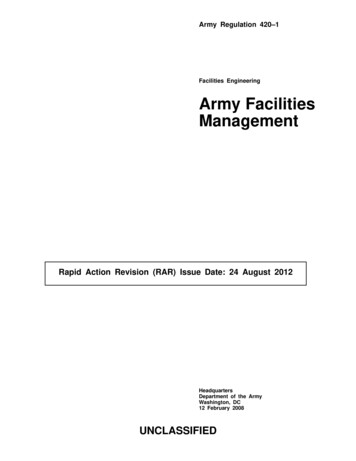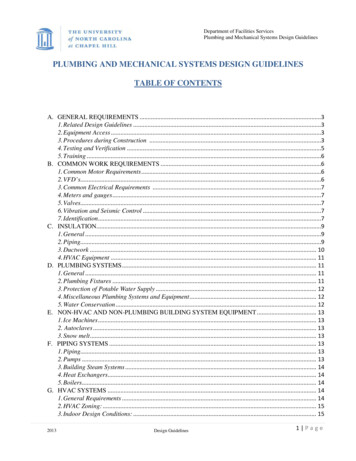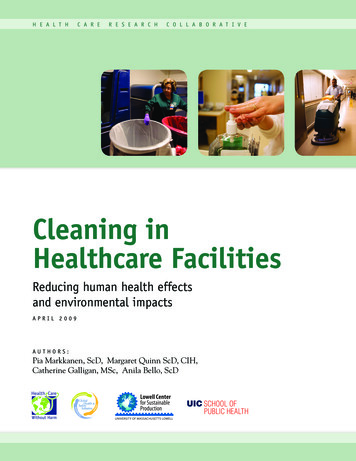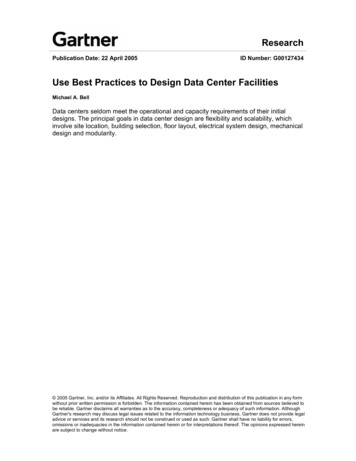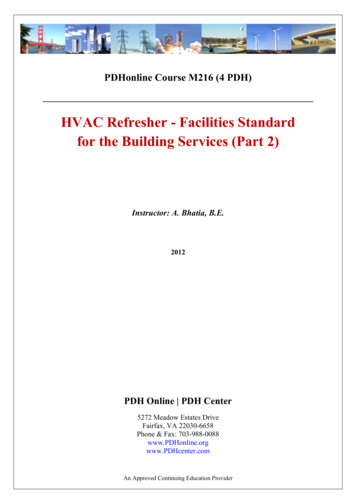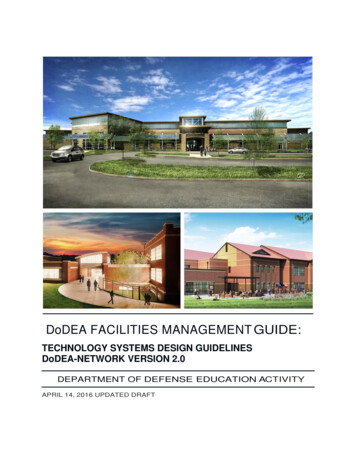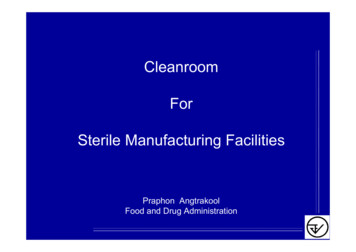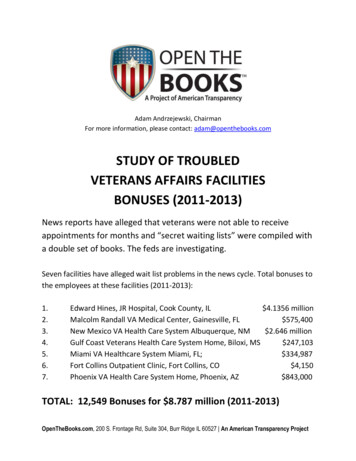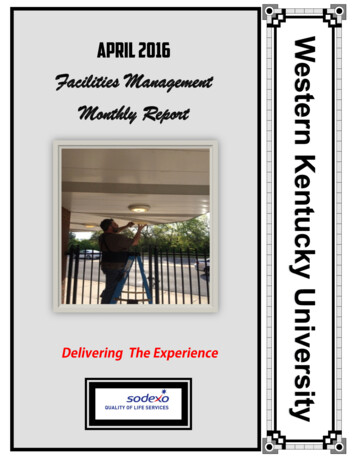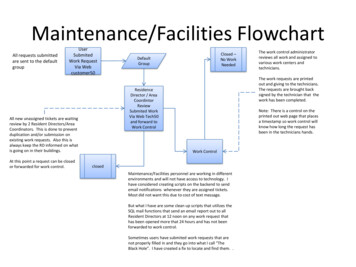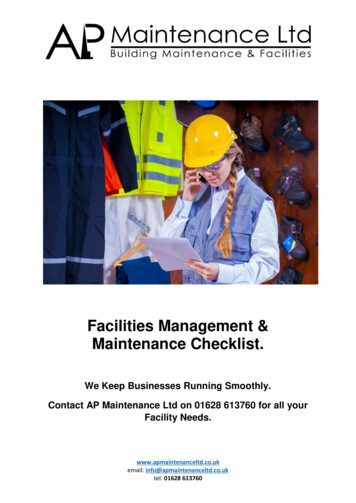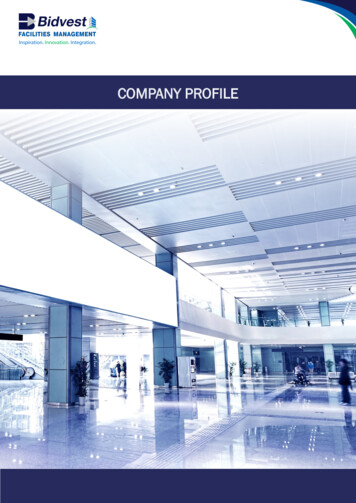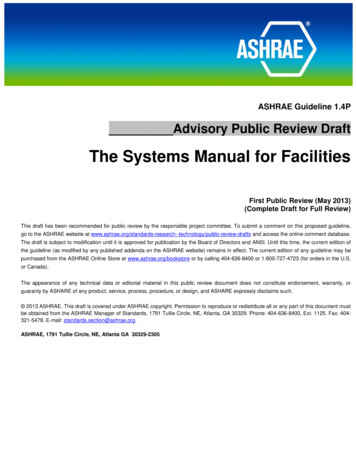
Transcription
ASHRAE Guideline 1.4PAdvisory Public Review DraftThe Systems Manual for FacilitiesFirst Public Review (May 2013)(Complete Draft for Full Review)This draft has been recommended for public review by the responsible project committee. To submit a comment on this proposed guideline,go to the ASHRAE website at ic-review-drafts and access the online comment database.The draft is subject to modification until it is approved for publication by the Board of Directors and ANSI. Until this time, the current edition ofthe guideline (as modified by any published addenda on the ASHRAE website) remains in effect. The current edition of any guideline may bepurchased from the ASHRAE Online Store at www.ashrae.org/bookstore or by calling 404-636-8400 or 1-800-727-4723 (for orders in the U.S.or Canada).The appearance of any technical data or editorial material in this public review document does not constitute endorsement, warranty, orguaranty by ASHARE of any product, service, process, procedure, or design, and ASHARE expressly disclaims such. 2013 ASHRAE. This draft is covered under ASHRAE copyright. Permission to reproduce or redistribute all or any part of this document mustbe obtained from the ASHRAE Manager of Standards, 1791 Tullie Circle, NE, Atlanta, GA 30329. Phone: 404-636-8400, Ext. 1125. Fax: 404321-5478. E-mail: standards.section@ashrae.org.ASHRAE, 1791 Tullie Circle, NE, Atlanta GA 30329-2305
ASHRAE Guideline Project Committee 1.4Cognizant TC: TC 7.9, Building CommissioningSPLS Liaison: Janice C. PetersonGerald J. Kettler Chair*Harry Jay Enck Vice-Chair*Bradley Brooks , SecretaryMichael J. King*Thomas E. Cappellin*Charles E. Dorgan*Justin Garner*Shailen Verma*Ole TeisenRichard D. HermannsMichael Khaw* Designates members of voting statusASHRAE STANDARDS COMMITTEEKenneth W. Cooper, ChairWilliam F. Walter, Vice-ChairDouglass S. AbramsonKarim AmraneCharles S. BarnabyHoy R. Bohanon, Jr.Steven F. BruningDavid R. ConoverSteven J. EmmerichJulie M. FergusonKrishnan GowriCecily M. GrzywaczRichard L. HallRita M. HarroldAdam W. HingeDebra H. KennoyJay A. KohlerRick A. LarsonMark P. ModeraJanice C. PetersonHeather L. PlattIra G. PostonDouglas T. ReindlJames R. TaubyJames K. VallortCraig P. WrayCharles H. Culp, III, BOD ExOConstantinos A. Balaras, COStephanie C. Reiniche, Manager of StandardsSPECIAL NOTEThis Guideline was developed under the auspices of the American Society of Heating, Refrigerating and Air-Conditioning Engineers(ASHRAE). ASHRAE Guidelines are developed under a review process, identifying a guideline for the design, testing, application, orevaluation of a specific product, concept, or practice. As a guideline it is not definitive but encompasses areas where there may be a varietyof approaches, none of which must be precisely correct. ASHRAE Guidelines are written to assist professionals in the area of concernand expertise of ASHRAE’s Technical Committees and Task Groups.ASHRAE Guidelines are prepared by project committees appointed specifically for the purpose of writing Guidelines. The projectcommittee chair and vice-chair must be members of ASHRAE; while other committee members may or may not be ASHRAEmembers, all must be technically qualified in the subject area of the Guideline.Development of ASHRAE Guidelines follows procedures similar to those for ASHRAE Standards except that (a) committee balance isdesired but not required, (b) an effort is made to achieve consensus but consensus is not required, (c) Guidelines are notappealable, and (d) Guidelines are not submitted to ANSI for approval.The Assistant Director of Technology for Standards and Special Projects of ASHRAE should be contacted for:a. interpretation of the contents of this Guideline,b. participation in the next review of the Guideline,c. offering constructive criticism for improving the Guideline, ord. permission to reprint portions of the Guideline.DISCLAIMERASHRAE uses its best efforts to promulgate Standards and Guidelines for the benefit of the public in light of available information andaccepted industry practices. However, ASH RAE does not guarantee, certify, or assure the safety or performance of any products,components, or systems tested, installed, or operated in accordance with ASHRAE’s Standards or Guidelines or that any tests conductedunder its Standards or Guidelines will be nonhazardous or free from risk.or Guidelines will be nonhazardous or free from risk.ASHRAE INDUSTRIAL ADVERTISING POLICY ON STANDARDSASHRAE Standards and Guidelines are established to assist industry and the public by offering a uniform method of testing for ratingpurposes, by suggesting safe practices in designing and installing equipment, by providing proper definitions of this equipment, and byproviding other information that may serve to guide the industry. The creation of ASHRAE Standards and Guidelines is determined by the needfor them, and conformance to them is completely voluntary.In referring to this Standard or Guideline and in marking of equipment and in advertising, no claim shall be made, either stated orimplied, that the product has been approved by ASHRAE.
ASHRAE Guideline 1.4P, The Systems Manual for FacilitiesFirst Public Review DraftCONTENTSASHRAE Guideline 1.4-201xThe Systems Manual for Facilities1.PURPOSE .52.SCOPE .53.DEFINITIONS .54.SYSTEMS MANUAL CONTENT, ORGANIZATION, AND UTILIZATION .75.PRE-DESIGN PHASE FUNCTIONS .146.DESIGN PHASE FUNCTIONS .167.CONSTRUCTION PHASE FUNCTION .178.OCCUPANCY AND OPERATION PHASE FUNCTION .199.EXISTING BUILDING FUNCTIONS .2110. COMPUTERIZATION AND INTERFACE WITH OTHER PROGRAMS .23INDEX TO ANNEXES.24NOTEWhen addenda, interpretations, or errata to this guideline have been approved, they can be downloadedfree of charge from the ASHRAE Web site at http://www.ashrae.org.3
ASHRAE Guideline 1.4P, The Systems Manual for FacilitiesFirst Public Review Draft(This foreword is not part of this guideline. It is merely informative and does not contain requirements necessary forconformance to the guideline.)FOREWORDDeveloping the Systems Manual encompasses gathering the information related to the facility,equipment, systems, and assemblies; from the planning, commissioning process, design,construction, testing, and training activities; and operations planning function and incorporating itinto a usable information resource, with indexes and cross references. This resource will include finalproject documentation, including OPR, BOD, the final Cx Plan, Cx Progress Reports, submittals,manufacturer installation manuals, manufacturer O&M manuals, system schematics, record drawings,testing results, and training and other relevant materials. This information is edited and organized tofocus upon the key systems (roofing, walls, fire alarm, chilled water, hot water, etc.), in the facility.Coordination with O&M personnel in developing standard formats and divisions (shops) is accomplishedto simplify future Systems Manual revisions.It is the intent that the Systems Manual be assembled in electronic format to facilitate access and reducestorage requirements. The electronic format will also reduce the possibility of loss for parts or all of theinformation. For Systems Manuals assembled in hard copy format, the larger documents such as recorddrawings, specifications, submittals, and O&M documents can be stored in secure locations with theselocations referenced in the Systems Manual.Also included in the Systems Manual is the development of periodic maintenance and information forinsertion into a computer maintenance management system (CMMS), including equipment make andmodel information, checking requirements, maintenance requirements, and troubleshooting items.If the Systems Manual is assembled during a commissioning process, the Commissioning Authority(CxA) shall be responsible for evaluating the development of the Systems Manual. At other times, theresponsible person or agency will be designated by the Owner.The entity responsible for developing the Systems Manual should include all items involved in theproject and capture the system and assembly data in either an electronic or printed version. In addition,printed operations, service, maintenance, spare parts list, and repair manuals may be provided. Thisentity (owner, contractor, design professional, CxA, other) shall have the skills of design, construction,and operations required to develop a cohesive Systems Manual.The required details for a full Systems Manual are enhanced in each of the Technical Guidelines. TheSystems Manual will have multiple sections depending upon the Owner’s designated requirements andthe number of systems focused upon during the facility development, renovation, or repair process.In summary, the Systems Manual contains information and documentation on the building design andconstruction, along with operational requirements, maintenance information, training and testingdocumentation for the use of building operations, and maintenance and optimization of the facility overits useful life.The format and content of the Systems Manual provided in this standard can be effectively used in bothnew construction and for assembling one for an existing building, even if the building is notcommissioned.Systems Manual Documentation Collection RequirementsThe Systems Manual process captures project requirements, design documentation, construction details,evaluation and testing results, and training programs as the information becomes available. Additionally,the recommended operating and maintenance procedures and ongoing documentation requirements areassembled and included. Changes to the manuals are expected as the building maintenance systemsare developed and changes to the systems occur.The arrangement of the Systems Manual shown in section 4 is based upon collection of documentation4
ASHRAE Guideline 1.4P, The Systems Manual for FacilitiesFirst Public Review Draftduring the normal construction process. It is also acceptable to arrange the documentation by system ifthat is the Owner’s preference, This system arrangement may require substantial additional time anddocumentation effort to rearrange the information.1. PURPOSEThis guideline provides procedures for producing a Systems Manual as a resource for training,operations, maintenance, and upgrading of facilities.2. SCOPEThis guideline applies to information from planning, commissioning process, design, construction,testing, and training activities, and operations planning for new, renovated, and existing facilities,equipment, and assemblies.3. DEFINITIONSAcceptance: A formal action, taken by a person with appropriate authority (which may or may not becontractually defined) to declare that some aspect of the project meets defined requirements, thuspermitting subsequent activities to proceed.Basis of Design (BOD): A document that records the concepts, calculations, decisions, and productselections used to meet the Owner’s Project Requirements (OPR) and to satisfy applicable regulatoryrequirements, standards, and guidelines. The document includes both narrative descriptions and lists ofindividual items that support the design process.Checklists: Project and element-specific checklists that are developed and used during all phases of thecommissioning process to verify that the OPR are being achieved. Checklists are used for generalevaluation, testing, training, and other design and construction requirements.Commissioning (Cx): See Commissioning Process.Commissioning Authority (CxA): An entity identified by the Owner who leads, plans, schedules, andcoordinates the commissioning team to implement the Commissioning Process.Commissioning Plan (Cx Plan): A document that outlines the organization, schedule, allocation ofresources, and documentation requirements of the Commissioning Process.Commissioning Process: A quality-focused process for enhancing the delivery of a project. Theprocess focuses upon verifying and documenting that all of the commissioned systems and assemblies areplanned, designed, installed, tested, operated, and maintained to meet the OPR.Commissioning Process Activities: Components of the Commissioning Process.Commissioning Progress Report: A written document that details activities completed as part of theCommissioning Process and significant findings from those activities and is continuously updated duringthe course of a project.Commissioning Team: The individuals and agencies, who through coordinated actions, are responsible forimplementing the Commissioning Process.Commissioning Testing: The evaluation and documentation of the equipment and assemblies: delivery5
ASHRAE Guideline 1.4P, The Systems Manual for FacilitiesFirst Public Review Draftand condition; installation; proper function according to the manufacturer’s s
This Guideline was developed under the auspices of the American Society of Heating, Refrigerating and Air-Conditioning Engineers (ASHRAE). ASHRAE Guidelines are developed under a review process, identifying a guideline for the design, testing, application, or evaluation of a specific product, concept, or practice. As a guideline it is not definitive but encompasses areas where there may be a varietyFile Size: 552KBPage Count: 108
